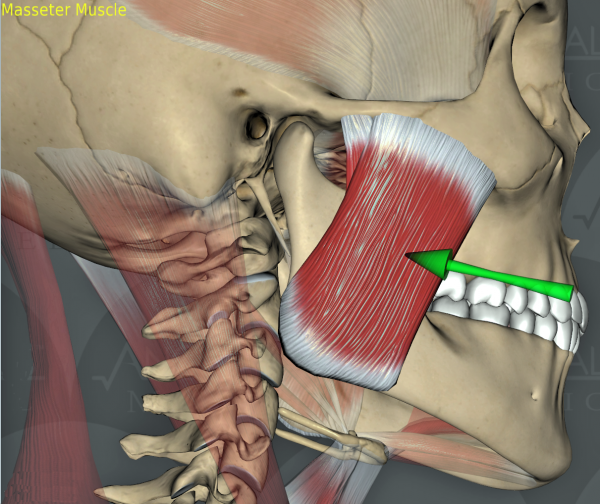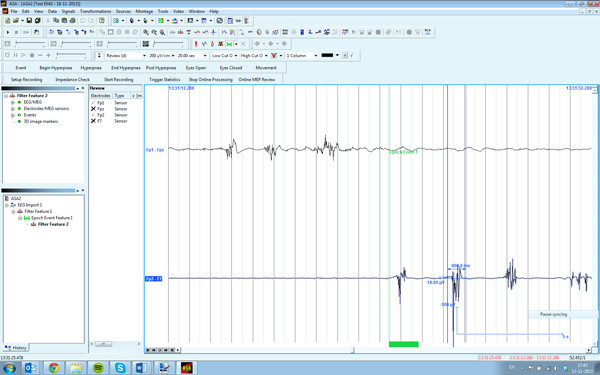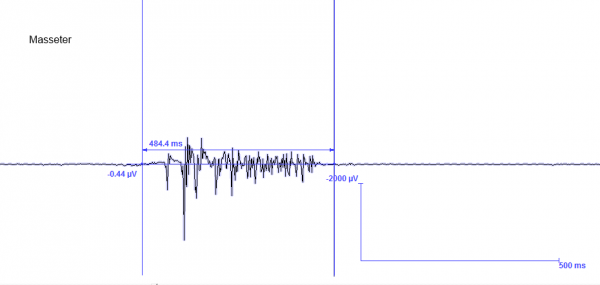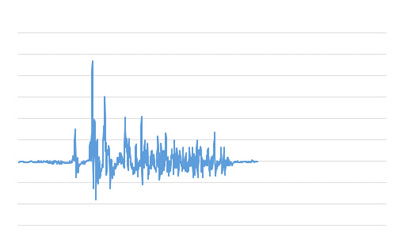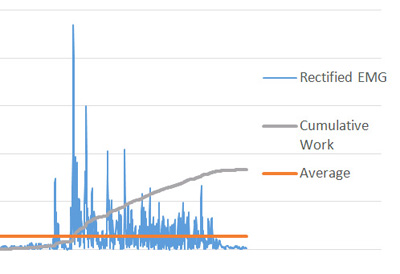- Home
- About ANT
-
Products

asa
asa is a highly flexible EEG/ERP and MEG analysis package with a variety of source reconstruction, signal analysis and MRI processing features.
.jpg)
eego mylab
The new frontier in multimodal brain research. With up to 16 kHz sampling rate, 256 EEG channels and unique software features, eego mylab gives you an unprecedented in-depth understanding of the human brain.

eego sports
eego sports offers complete freedom to collect high-density EEG data, bipolar EMG signals, and a variety of physiological sensor data, wherever and whenever required, with publish quality data in less than 15 minutes!

waveguard net
The waveguard net sets a new standard for research applications requiring high-density EEG data acquisition with quick preparation time, high flexibility, and subject comfort.

visor2
Our new and upgraded visor2 solutions integrate all the latest technologies for navigated rTMS, dual-coil navigation support, EEG-TMS recordings and pre-surgical evaluation for the highest quality in research and clinical procedures.

powerMAG ANT
The PowerMAG ANT 100 rTMS stimulator is designed for the specific needs of high-end TMS applications. Powerful high-frequency TMS as well as high precise single pulse and repetitive pulse protocols are combined in one single device.

xensor
xensor offers the solution for digitization of 3D electrode positions. xensor takes care of the whole procedure; it records, visualizes and stores positions acquired with a dedicated digitizer.

waveguard original
waveguard original is the cap solution for EEG measurements compatible with fMRI, MEG and TMS system. Use of active shielding guarantees performance in even the most demanding environments.

waveguard connect
waveguard connect EEG caps are a perfect match for hospitals and institutes aiming at reliable EEG, maximum uptime and great patient comfort! For optimal signal quality, the electrodes are made of pure, solid tin.

waveguard touch
waveguard touch is a dry electrode EEG cap. The unique Ag/AgCl coated soft polymer electrodes provide stable, research-grade EEG signals while maintaining subject comfort. The combination of these innovative dry electrodes and the industry-leading waveguard cap makes waveguard touch the best solution for dry EEG.

smartmove
smartmove allows planning of a complete TMS session ahead by defining stimulation sites based on anatomical MRI information and functional information like fMRI, PET or EEG/MEG.
Stay - References
- Support
- Events
- News
- Contact Us
You are here
Facial EMG analysis for mastication experiments
Facial EMG analysis for mastication experiments
In this application case the eegosports system was used for the measurement of facial EMG, more specifically with a focus on mastication experiments.
The test setup consisted of an eegosports complete system with 64 referential channels. Of these, 4 referential channels were configured in a bipolar setup. One bipolar channel was located on the participants right thumb (Abducator Pollicis Brevis) and the other one on the participants right cheek muscle (Superficial Masseter).
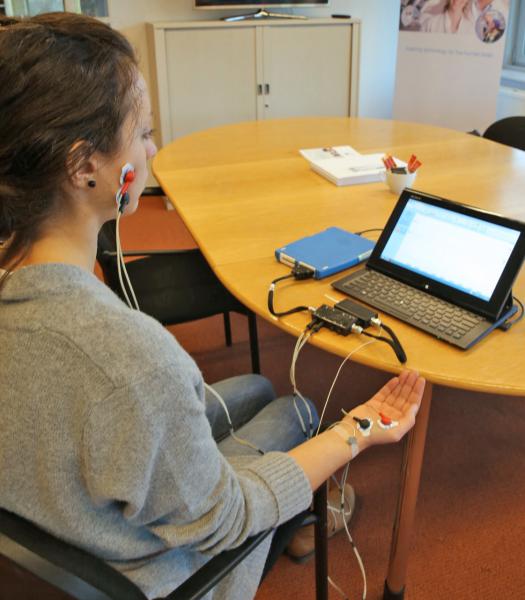
Figure 1: Experiment setup
Superficial Masseter
The superficial Masseter was located by palpation when the participant clenched his teeth. The bipolar EMG leads were connected to two Kendall ARBO ECG electrodes, 24mm in diameter spaced approximately 6 cm apart (heart to heart) (see also Mioche et al. 2004). Please note that the skin was not extensively prepared, but still impedances and signal quality were found to be satisfactory.
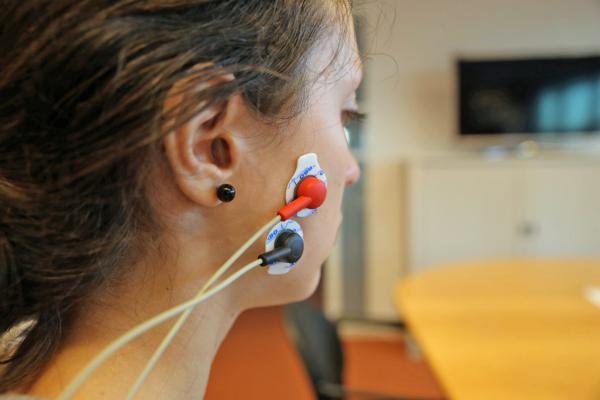 |
|
Figure 2: Electrodes placed on Superficial Figure 3: Anatomical image of Superficial
Masseter Masseter
Abductor Pollicis
As a control, the participant’s left thumb was also included in the recording as a control (see Figure 4). Electrodes were placed approximately 7 cm apart on the Abductor Pollicis. The ground electrode can also be seen in Figure 4, it is placed on the boney area at the extremity of the underarm (radial styloid).
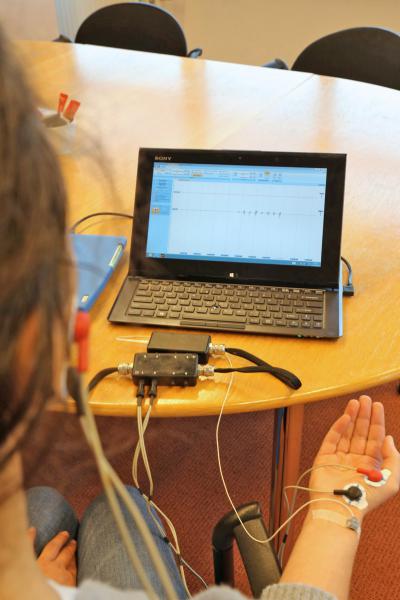
Figure 4: Overview of the EMG connections and the recording hardware
Anterior Temporalis
In a full mastication experiment, one might also want to include the Anterior Temporalis muscle in the data recording (and of course both muscles mirrored on the other side of the head), as this muscle is also heavily used during chewing. The setup for recording EMG at this location is however beyond the scope of this showcase.
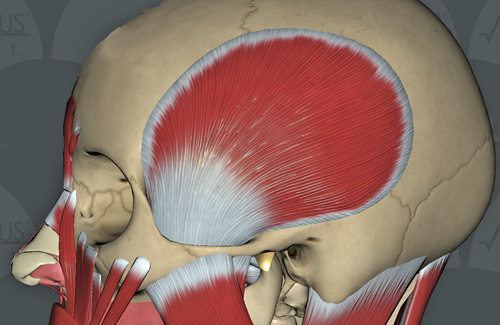
Figure 5: Anatomical image of the Anterior Temporalis muscle
Data recording
With the right montage data recording is quite straightforward. The montage is only configured once, and can be re-used with every recording. Impedance check shows the impedance for every electrode in kOhms. Assessment of data quality is easily done in the live EEG preview.
Data analysis
With the eegosports asa is shipped. asa is very powerful and advanced for EEG analysis and has some useful features for EMG analysis as well. First we apply some basic high pass filtering (3Hz - ∞) and notch filtering (50Hz).
Figure 6: asa analysis software
Figure 7: Recording extract of Abductor Pollicis and Masseter
After this, one can do automatic peak detection, averaging, Hilbert transformation, frequency analysis or manually inspect specific peaks. Below is an example of a burst of EMG. One can manually move the cursor over the burst to explore the data and automatically see the latency and height of the peak or offset.
Figure 8: Extract of Masseter movements
Export to ASCII
Because ASA is mainly focused at EEG analysis, some functions which are specific to EMG analysis are not available. However, ASA can easily export to ASCII files, which are compatible with matrix-based software programs like Excel and MatLab. Plotting is often easy and straightforward. (Note that ASA by default plots EEG/EMG traces with the negative side of the axis pointing upwards, while Excel plots the positive values upwards, see Figure 9 below.)
Figure 9: Filtered EMG
Rectifying the signal is easily done in for example Excel by using the ABS() function. The result can be seen in Figure 10 in the blue trace.
Other functions are also available, like calculating the average of the peaks, or the cumulative amount of work the muscle has done. (See below, orange for average and grey for cumulative work.)
Figure 10: Rectified EMG
eegosports, the ultra-mobile eeg & emg solution
The compact eegosports amplifier is designed with mobility in mind. eegosports offers complete freedom to collect data wherever and whenever required -up to 64 channels of EEG and up to 24 bipolar EMG channels, with publish quality data in less than 15 minutes! While small, eegosports is highly durable and offers a host of add-ons and modules to meet the needs of nearly any EEG or EMG researcher. Recording can be done in nearly any environment on nearly any subject, even world-class athletes at work. Powerful, highly adaptable, and intuitive: eegosports is a system for collecting reliable high-density data in real-life like no other.


 Read more
Read more.jpg)

